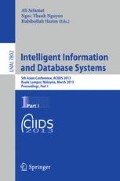Abstract
The advancement of microarray technology allows obtaining genetic information from cancer patients, as computational data and cancer classification through computation software, has become possible. Through gene selection, we can identify certain numbers of informative genes that can be grouped into a smaller sets or subset of genes; which are informative genes taken from the initial data for the purpose of classification. In most available methods, the amount of genes selected in gene subsets are dependent on the gene selection technique used and cannot be fine-tuned to suit the requirement for particular number of genes. Hence, a proposed technique known as gene range selection based on a random forest method allows selective subset for better classification of cancer datasets. Our results indicate that various gene sets assist in increasing the overall classification accuracy of the cancer related datasets, as the amount of genes can be further scrutinized to create the best subset of genes. Moreover, it can assist the gene-filtering technique for further analysis of the microarray data in gene network analysis, gene-gene interaction analysis and many other related fields.
Access this chapter
Tax calculation will be finalised at checkout
Purchases are for personal use only
Preview
Unable to display preview. Download preview PDF.
References
Paz, J.L., Seeberger, P.H.: Recent Advances and Future Challenges in Glycan Microarray Technology. In: Chevolot, Y. (ed.) Carbohydrate Microarrays, vol. 808, pp. 1–12. Humana Press (2012)
Pham, T.D., Wells, C., Crane, D.I.: Analysis of Microarray Gene Expression Data. Current Bioinformatics 1, 37–53 (2006)
Liew, A.W.-C., Law, N.-F., Yan, H.: Missing value imputation for gene expression data: computational techniques to recover missing data from available information. Briefings in Bioinformatics 12, 498–513 (2011)
Duval, B., Hao, J.-K.: Advances in metaheuristics for gene selection and classification of microarray data. Briefings in Bioinformatics 11, 127–141 (2010)
Wu, D., Rice, C., Wang, X.: Cancer bioinformatics: A new approach to systems clinical medicine. BMC Bioinformatics 13, 71 (2012)
Saeys, Y., Inza, I., Larrañaga, P.: A review of feature selection techniques in bioinformatics. Bioinformatics 23, 2507–2517 (2007)
Van Steen, K.: Travelling the world of gene–gene interactions. Briefings in Bioinformatics 13, 1–19 (2012)
Hua, J., Tembe, W.D., Dougherty, E.R.: Performance of feature-selection methods in the classification of high-dimension data. Pattern Recogn. 42, 409–424 (2009)
Wong, G., Leckie, C., Kowalczyk, A.: FSR: feature set reduction for scalable and accurate multi-class cancer subtype classification based on copy number. Bioinformatics 28, 151–159 (2012)
Nanni, L., Brahnam, S., Lumini, A.: Combining multiple approaches for gene microarray classification. Bioinformatics 28, 1151–1157 (2012)
Asyali, M.H., Colak, D., Demirkaya, O., Inan, M.S.: Gene Expression Profile Classification: A Review. Current Bioinformatics 1, 55–73 (2006)
Lin, W.-J., Chen, J.J.: Class-imbalanced classifiers for high-dimensional data. Briefings in Bioinformatics (2012)
Boulesteix, A.-L., Bender, A., Lorenzo Bermejo, J., Strobl, C.: Random forest Gini importance favours SNPs with large minor allele frequency: impact, sources and recommendations. Briefings in Bioinformatics 13, 292–304 (2012)
Breiman, L.: Random Forests. Mach. Learn. 45, 5–32 (2001)
Diaz-Uriarte, R., Alvarez de Andres, S.: Gene selection and classification of microarray data using random forest. BMC Bioinformatics 7, 3 (2006)
Moorthy, K., Mohamad, M.S.: Random forest for gene selection and microarray data classification. Bioinformation 7, 142–146 (2011)
Ramaswamy, S., Ross, K.N., Lander, E.S., Golub, T.R.: A molecular signature of metastasis in primary solid tumors. Nature Genetics 33, 49–54 (2003)
van ’t Veer, L.J., Dai, H., van de Vijver, M.J., He, Y.D., Hart, A.A., Mao, M., Peterse, H.L., van der Kooy, K., Marton, M.J., Witteveen, A.T., Schreiber, G.J., Kerkhoven, R.M., Roberts, C., Linsley, P.S., Bernards, R., Friend, S.H.: Gene expression profiling predicts clinical outcome of breast cancer. Nature 415, 530–536 (2002)
Alon, U., Barkai, N., Notterman, D.A., Gish, K., Ybarra, S., Mack, D., Levine, A.J.: Broad patterns of gene expression revealed by clustering analysis of tumor and normal colon tissues probed by oligonucleotide arrays. Proceedings of the National Academy of Sciences 96, 6745–6750 (1999)
Golub, T.R., Slonim, D.K., Tamayo, P., Huard, C., Gaasenbeek, M., Mesirov, J.P., Coller, H., Loh, M.L., Downing, J.R., Caligiuri, M.A., Bloomfield, C.D., Lander, E.S.: Molecular classification of cancer: class discovery and class prediction by gene expression monitoring. Science 286, 531–537 (1999)
Singh, D., Febbo, P.G., Ross, K., Jackson, D.G., Manola, J., Ladd, C., Tamayo, P., Renshaw, A.A., D’Amico, A.V., Richie, J.P., Lander, E.S., Loda, M., Kantoff, P.W., Golub, T.R., Sellers, W.R.: Gene expression correlates of clinical prostate cancer behavior. Cancer Cell 1, 203–209 (2002)
Efron, B., Tibshirani, R.: Improvements on Cross-Validation: The .632+ Bootstrap Method. Journal of the American Statistical Association 92, 548–560 (1997)
Author information
Authors and Affiliations
Editor information
Editors and Affiliations
Rights and permissions
Copyright information
© 2013 Springer-Verlag Berlin Heidelberg
About this paper
Cite this paper
Moorthy, K., Bin Mohamad, M.S., Deris, S. (2013). Multiple Gene Sets for Cancer Classification Using Gene Range Selection Based on Random Forest. In: Selamat, A., Nguyen, N.T., Haron, H. (eds) Intelligent Information and Database Systems. ACIIDS 2013. Lecture Notes in Computer Science(), vol 7802. Springer, Berlin, Heidelberg. https://doi.org/10.1007/978-3-642-36546-1_40
Download citation
DOI: https://doi.org/10.1007/978-3-642-36546-1_40
Publisher Name: Springer, Berlin, Heidelberg
Print ISBN: 978-3-642-36545-4
Online ISBN: 978-3-642-36546-1
eBook Packages: Computer ScienceComputer Science (R0)

